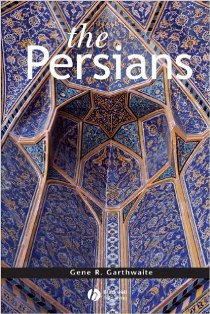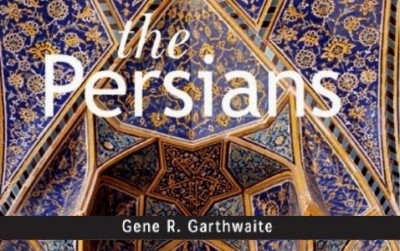The Persians by Gene R. Garthwaite[1] addresses the history of Iran from the Achaemenians (c.550-331 BC) up to 2003. In the introduction, Garthwaite specifies that the term of Persia and Persians are as many metaphorical notions that can not be easily categorized: “Generally speaking Persia/Persians is used in the United Kingdom or when referring to ancient Iran/Iranians from sixth century BC to the third century AD (p.1). Reza Shah (1926-1941) decreed in 1935 that Iran be used exclusively in official and diplomatic correspondence. Iran was the term commonly used in Iran and by Iranians except for the seventh to thirteenth centuries”. (p.1)
The book is composed of the following chapters:
1- Persia: Place and Idea
2- The Achaemenians (c.550-331 BC)
3- Alexander (330-323 BC), the Seleucids (312-129 BC), and the Parthians (247 BC 224 AD)
4- The Sasanians (c. 224-651)
5- “Non-Iran”: Arabs, Turks, and Mongols in Iran
6- The Safavids (1501-1722)
7- The Qajars (1796-1926)
8- Iran, 1921-2003: Pahlavi and Islamic Republican Iran
This paper reviews Chapter five to examine the history of medieval Iran from the Arab invasion up to the Safavid reign (1501-1736). Unlike other chapters that are specified with the name of a particular dynasty chapter, five examines many dynasties including the Umayyad and Abbasid Caliphate to the dynasties in Iran from the Taherids (821-871) to the Aq Quyunlu (1378-1501). The main idea followed in this chapter is that Iran after the Arab invasion up to the rise of the Safavids was ruled by non-Persian governments; however, the universal ruler was identified with Iran even though there was no Iranian government: “Persian /Iran and the Persian/Iranians did not disappear with the collapse of the Sasanian empire (224-651) in the mid-seventh century. Place, of course, continued; identity as a people and culture persisted and would be revived in government but neither on an imperial nor geographic basis until the sixteenth century” (p. 118).
It was just under the Abbasids (750-1258) that Persian universal rulership and the necessary ethnic and religious qualifications to rule were revived. Persian rulership survived in that first century of Islamic rule, because of the continued utilization of Sasanian bureaucrats and administration. It is in this process that Persian rulership acquired Islamic legitimacy and the Iranian historical memory acquired its mythical power: “In the tenth century, when Persian principalities emerged once again, the Persian past was crystallized in the great national epic, the Shahnameh, by the poet Firdausi, which has had a profound impact in shaping Persian identity down to the present” (p. 118).
Garthwaite proposes many remarkable viewpoints about the continuity and change in cultural and literary tendencies of Iranians throughout time, but he does not support his ideas with tangible evidence and historical examples. The Arab invasion of Iran regardless of replacing the Iranian rulership impacted the religion of Persian and Islam gradually supplanted Zoroastrianism. Garthwaite proposes many general remarks about the conversion of Iranians from Islam into Zoroastrianism. One of the main remarks is that religion and kingship were connected in the Iranian culture so that neither can dispense with the other. In this regard, the demise of the Sasanian Empire led to the diminishment of Zoroastrianism. This central idea of the close relationship between religion and kingship which ended up with the survival of the Iranian native religion was incorporated into medieval Islamic political theory. The other plausible remark proposed by Garthwaite about the decline of the Zoroastrian religion was that it was “largely the religion of the ruling elites and the residents of cities or of settlements and shrines closely associated with the administrative and religious leaders and it had little appeal for most Iranians (p. 121). However, the author does not provide any evidence for his proposal: “The process of conversion is difficult to reconstruct and can not easily be documented and dated. Probably it occurred first among the elites and in urban centers; there were both economic and status advantages to conversion from whatever religion” (p.121).
Unlike many countries of the Middle East whose language changed to Arabic, the Iranians retained their own language, which is an Indo-European one; although, Persian over a very long period of time incorporated much of Arabic vocabulary (p.120).
The Abbasid caliph became the great king of kings from the ancient Persian tradition: descent in an Arab dynastic family with links to the prophet, elaborate court ceremonial and ritual, remote and distant from the population as a whole, and connected to the bureaucracy and the military and through them to the empire as a whole: “Two institutions, however, that could be directly controlled and manipulated by the caliph were the bureaucracy and the military, and the relationship of the caliph to them was similar to the Sasanian king of kings to them” (p. 123).
Besides the Abbasid Caliphate, Dynasties in Iran from the Taherids to the Aq Quyunlu are examined. Among them, the Samanids had a pivotal role in Iranian history between the Sasanian period and the Safavid period when earlier elements of Iranian rulership and political culture re-emerged in the sixteenth century in the hands of a Persian dynastic family. Samanid rule (875-999) and administration and rules served as a model for subsequent rulers of Iran and Central Asia, including the Ghaznavids (963-1186), the Saljuqs (1037-1194), and the Ilkhanids (1256-1335). Most importantly, the stability and wealth of the Samanids allowed them to maintain and patronize a rich cultural life, and it is through patronage that the Samanids left their mark on all subsequent Iranian history as they laid the definitive basis for Iranian identity over and against the Turks of Central Asia and the Arabs to the west (p. 126).
The Buyids (932-1055) ruling in Central and Western Iran harkened directly to the great Pre-Islamic past by using a genealogy linking the Buyids with the Sasanians. Despite the Buyid representation as being Shi’a and as something of Sasanian successors, Turks seem not to have concerned themselves with supplanting the Sunni Abbasid caliphate and defended it against the Fatimids, Isma’ili Shia, of Egypt. The Ghaznavids and the Saljuqs, however, would play their Sunni card, when they claimed that in defeating the Buyids respectfully in Rayy and Baghdad they were releasing the caliph from the Shi'i hegemony (p.128).
Turks constitute the third most dominant linguistic/ethnic group in the Middle East along with the Arabs and Iranians. The arrival of the Saljuqs signaled the immigration of Turks with family and flocks in and across Iran into the whole of the Middle East. In 1055, Baghdad and the caliph were freed from the Buyid hegemony when Tuqrul entered Baghdad in Sunni Triumph. The caliph invested him with the title of sultan, and in 1058 with the title of “King of the east and west” which recalls ancient Mesopotamian titles. While the theoretical case is made that in Islam there is no separation between religion and affairs of state and that in the caliphate there is no distinction between spiritual and secular roles, the sultan in practice assumed the secular role in providing military and administrative leadership. Essentially, the title of Sultan was used after this to legitimize rulers who had seized power through military forces (p. 130). After the Mongols killed the last caliph in 1258 and ended the caliphate, the title would be used only by those who held de facto power.
The overwhelming Mongol impact on Iran, however, was negative. Many people were killed or displaced. Cities were leveled, and the land was laid waste directly by invasions and nomadic incursions, or indirectly with the flight of peasants from the breakdown of the irrigation system, or through extortionate taxation. Ghazan’s reforms (1295-1304) came too late. Any subsequent agricultural recovery was offset by late Ilkhanid factionalism and misrule and then by the rise and ravages of Timurlane (1370-1405) at the end of the 14th century. In the answer to this question that what from Iran’s past continued in the Mongol era Garthwaite states: “A complex society and economy based on pastoralism, agriculture, and commerce; a military tradition with an emphasis on cavalry and bowmen, but based more on nomads; acceptance of religious and ethnic diversity; under Ilkhan the centrality between west and east Asia; acceptance of autonomy; a tradition of Iranian administration and a consciousness of that historical tradition; financing of the military and administration through the land grants; and patronage of architecture, the arts, and the learning” (p. 147).
Going through the history of post-Mongols from the Timurids to the Aq Quyunlu, Garthwaite concludes that remarkably from 641 with the defeat of the Sasanians until 1501, with the rise of the Safavids, Persian universal rulership and its link with Iran and its political culture did not disappear despite the ending of the Sasanian dynasty, the conversion of the Iranians to Islam, and the onslaught of the Turko-Mongol invasions. This same process was repeated with the Turkic-Mongol dynasties which even reinforced hierarchy, family descent, and the idea of the autocratic ruler and his realm as the equipoise between God and the universe (p. 156).
Maryam Kamali

[1]. Gene R. Garthwaite, Malden, MA: Blackwell Pub, 2005.

